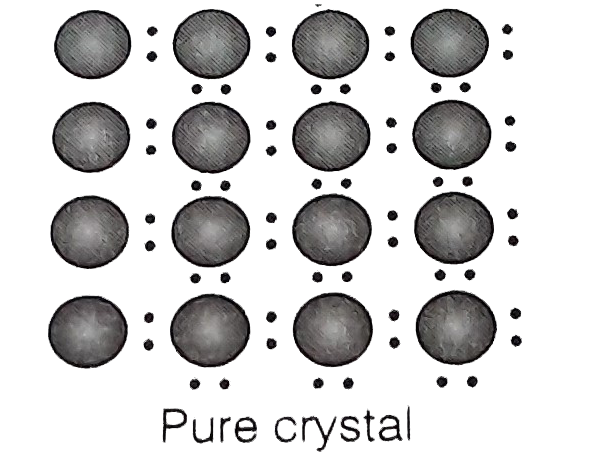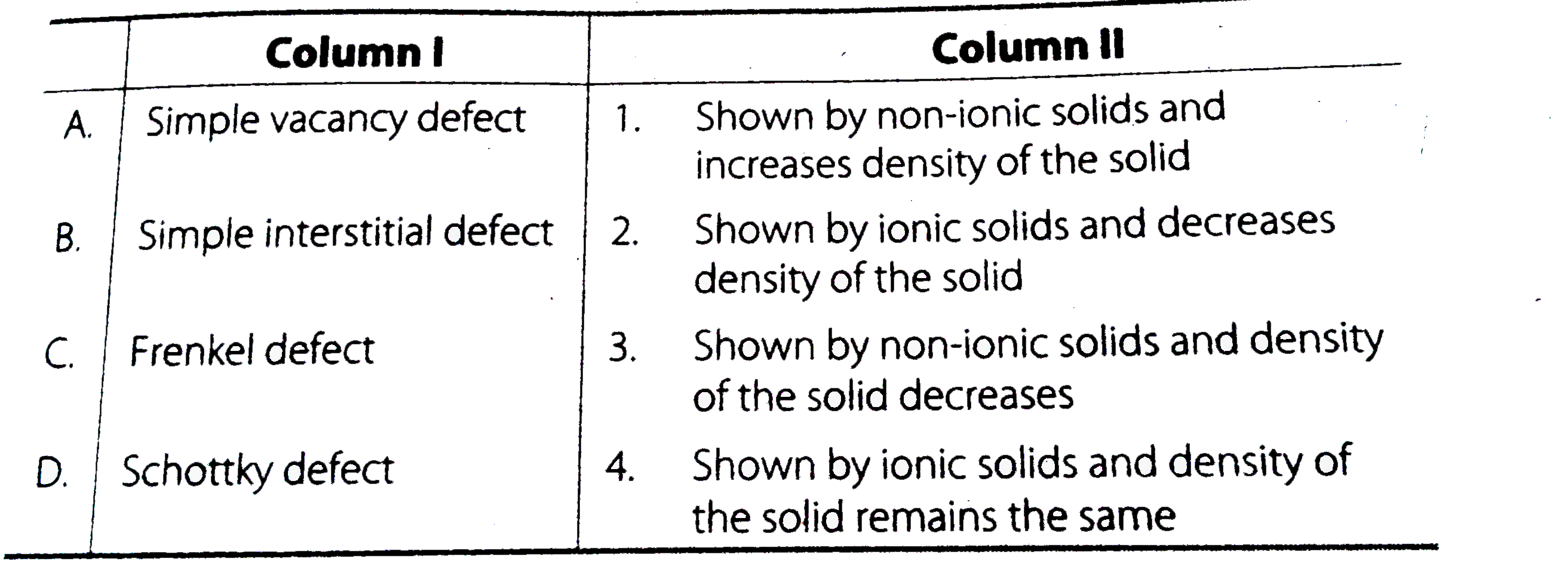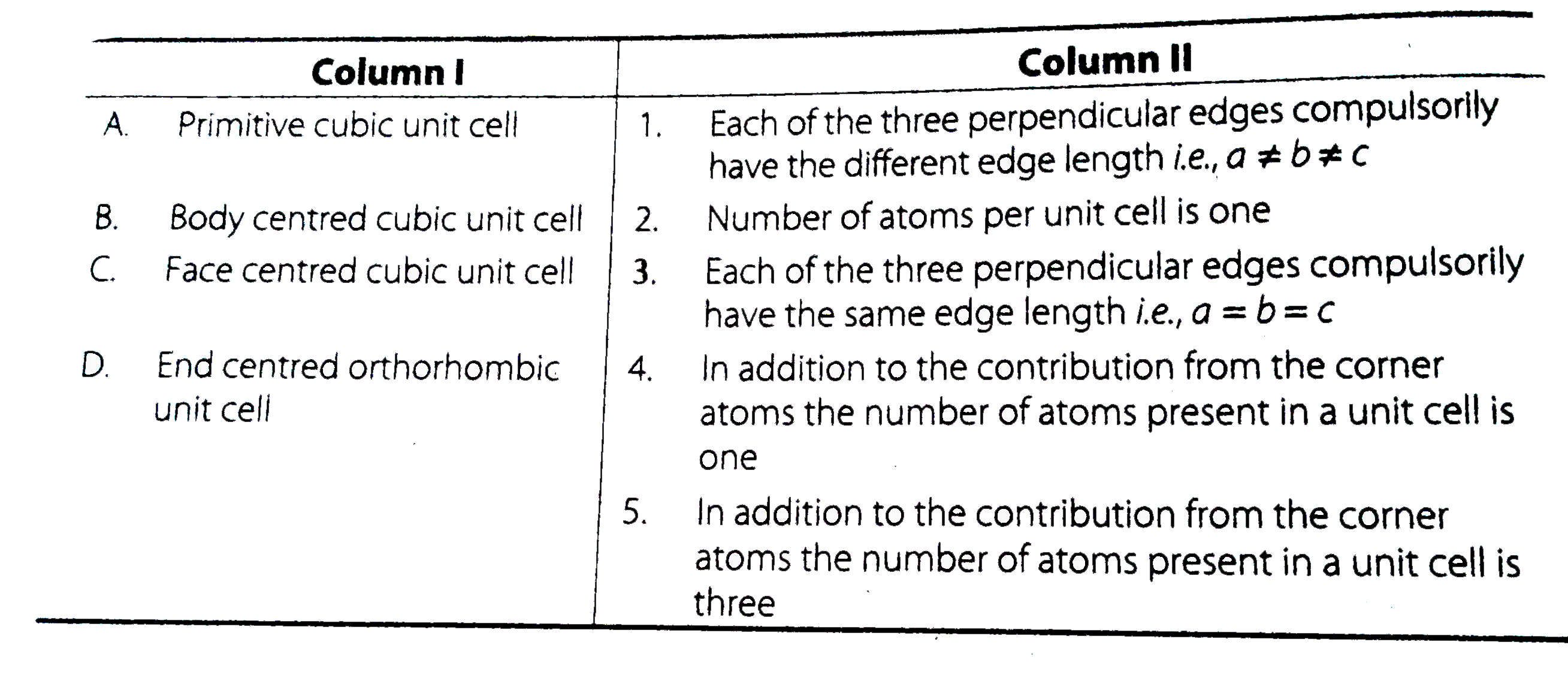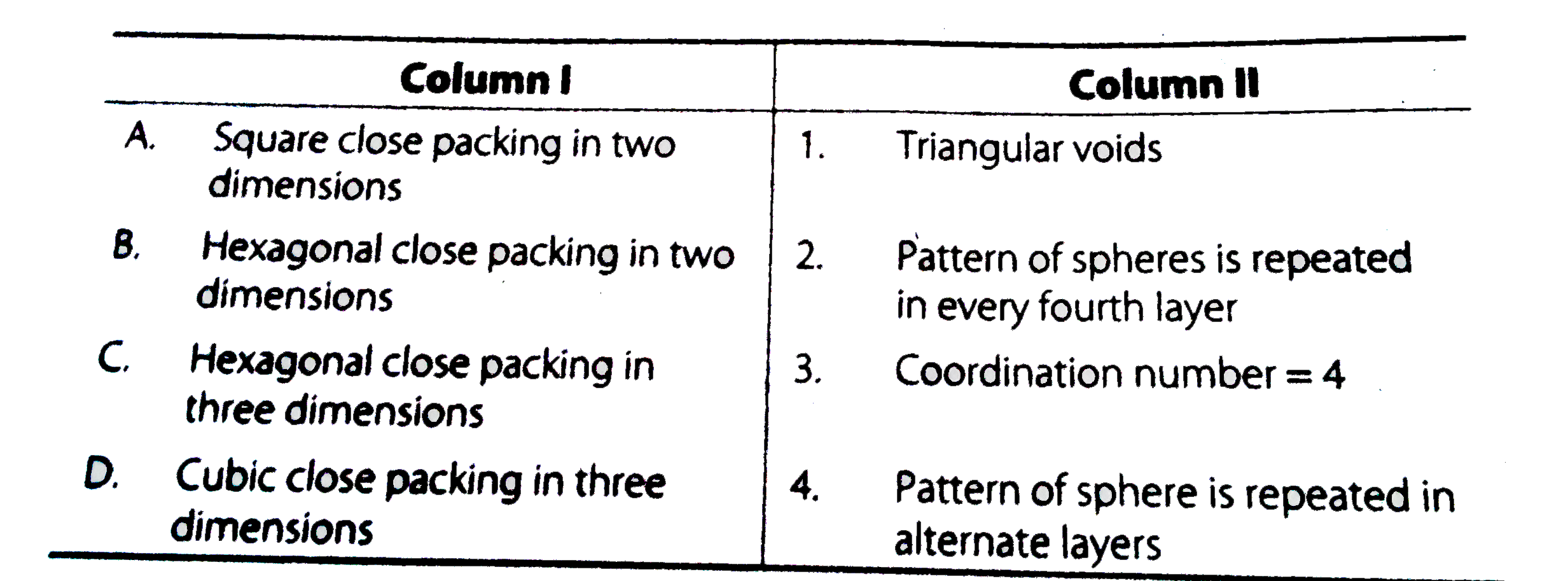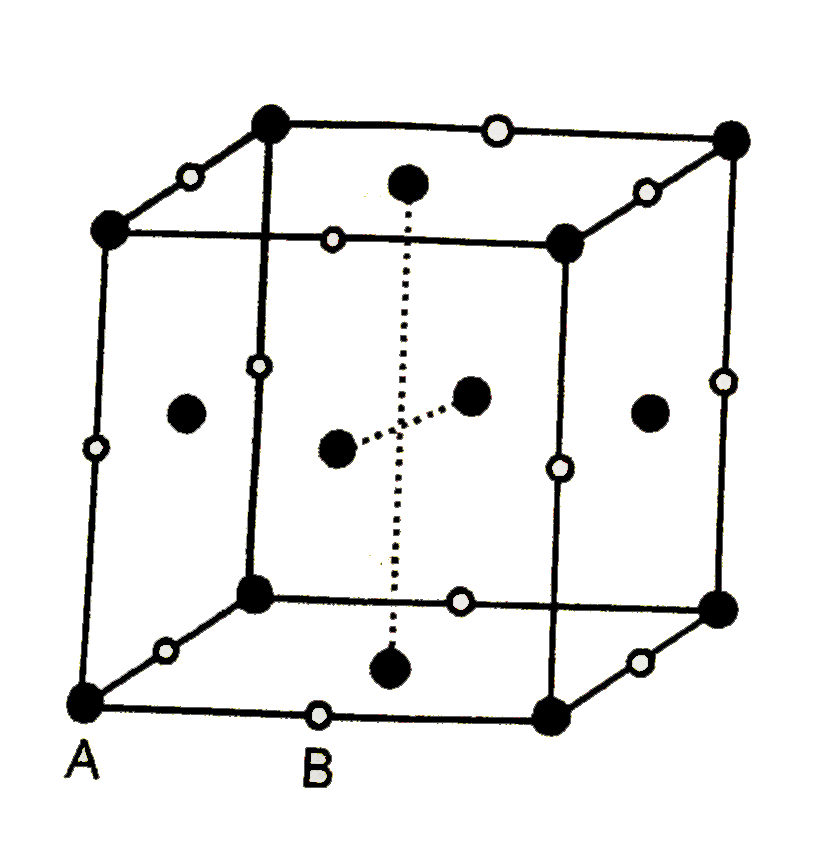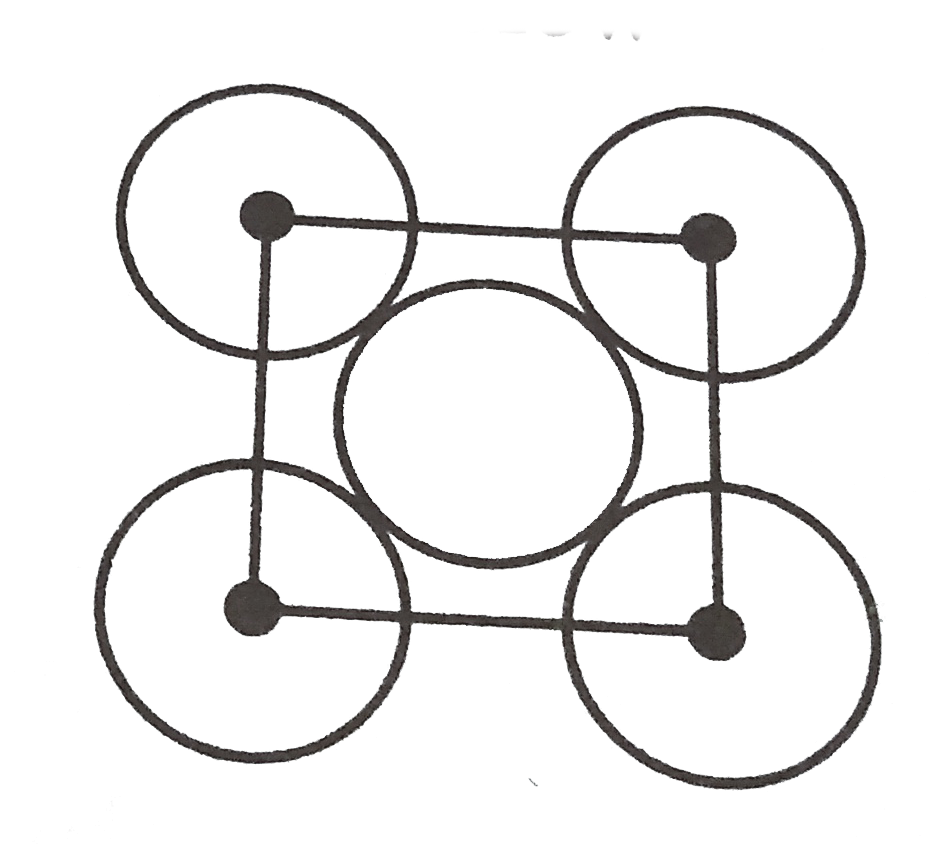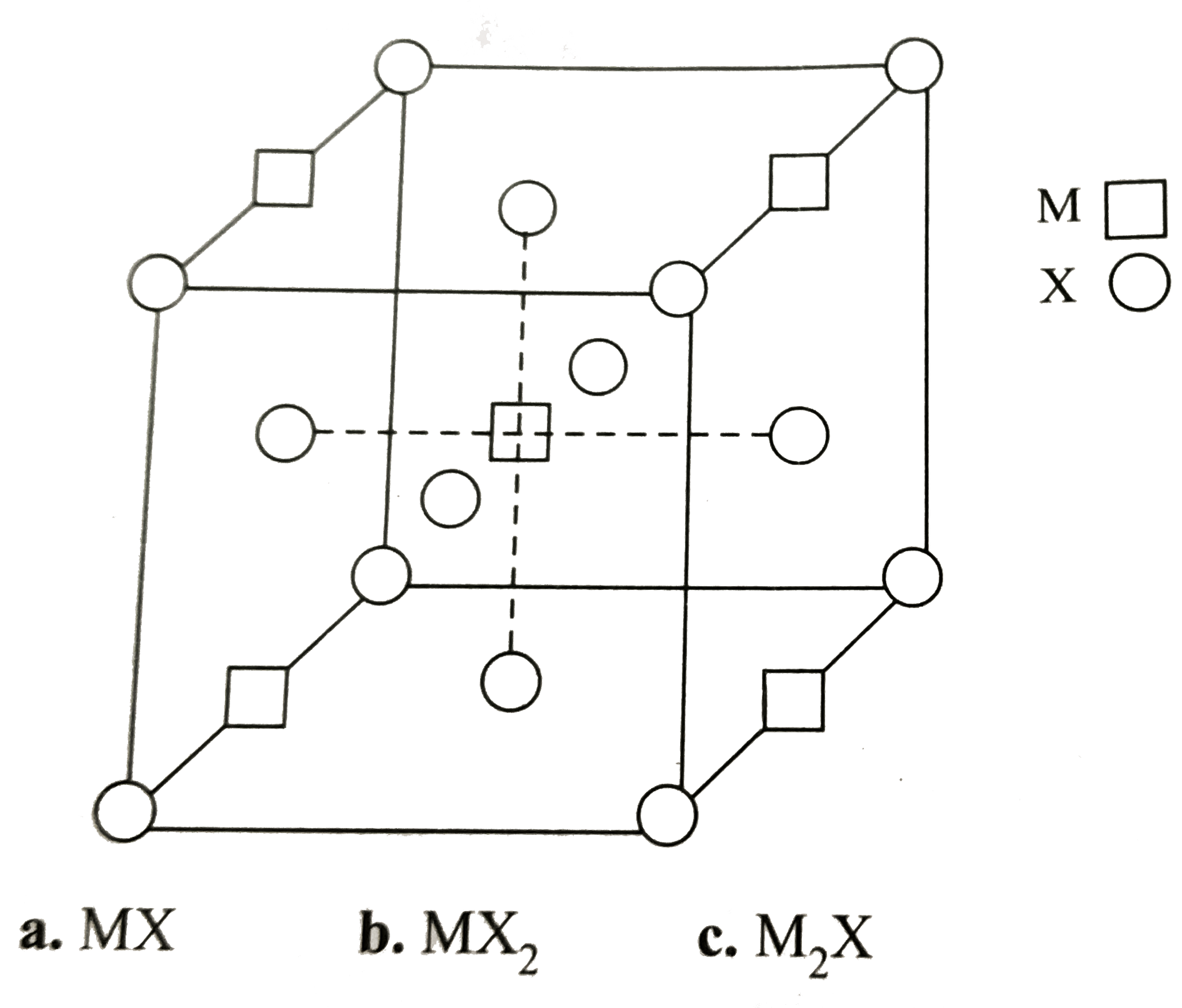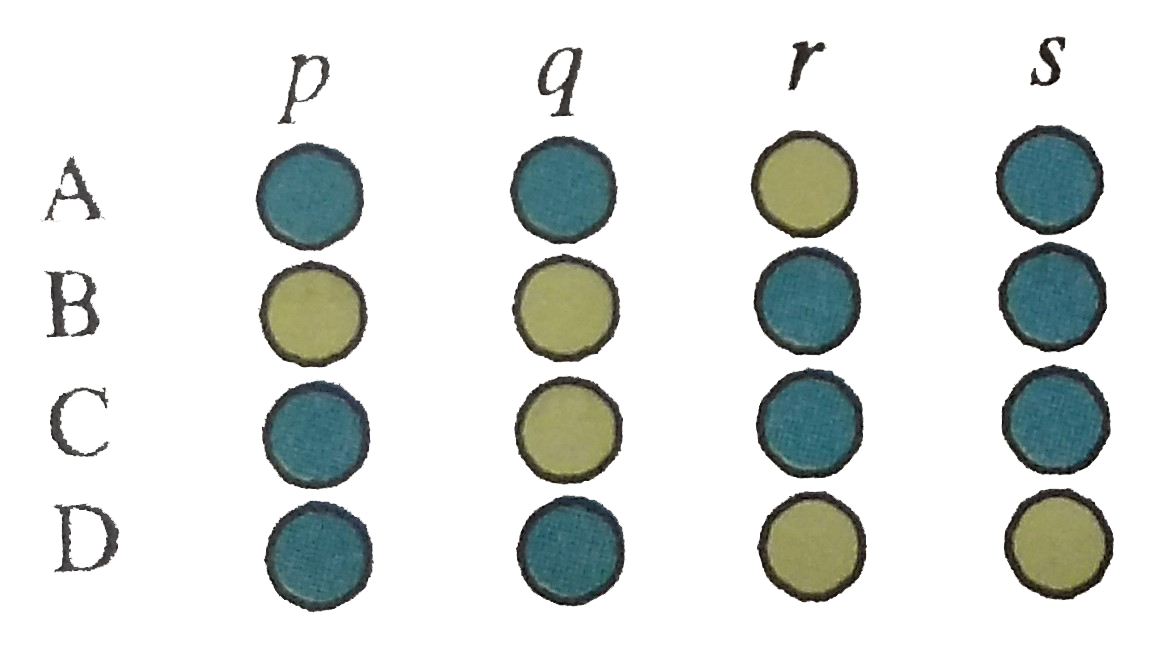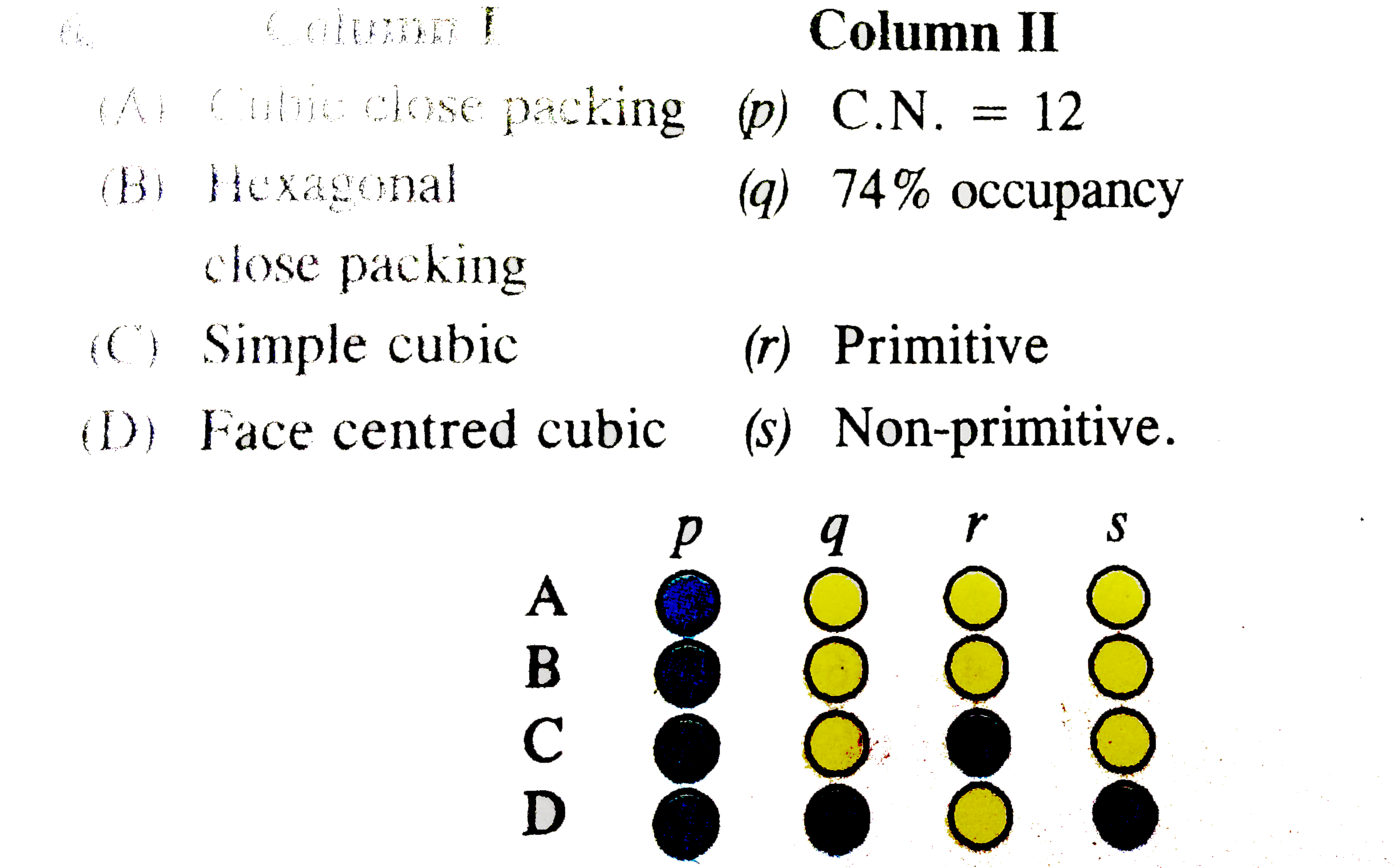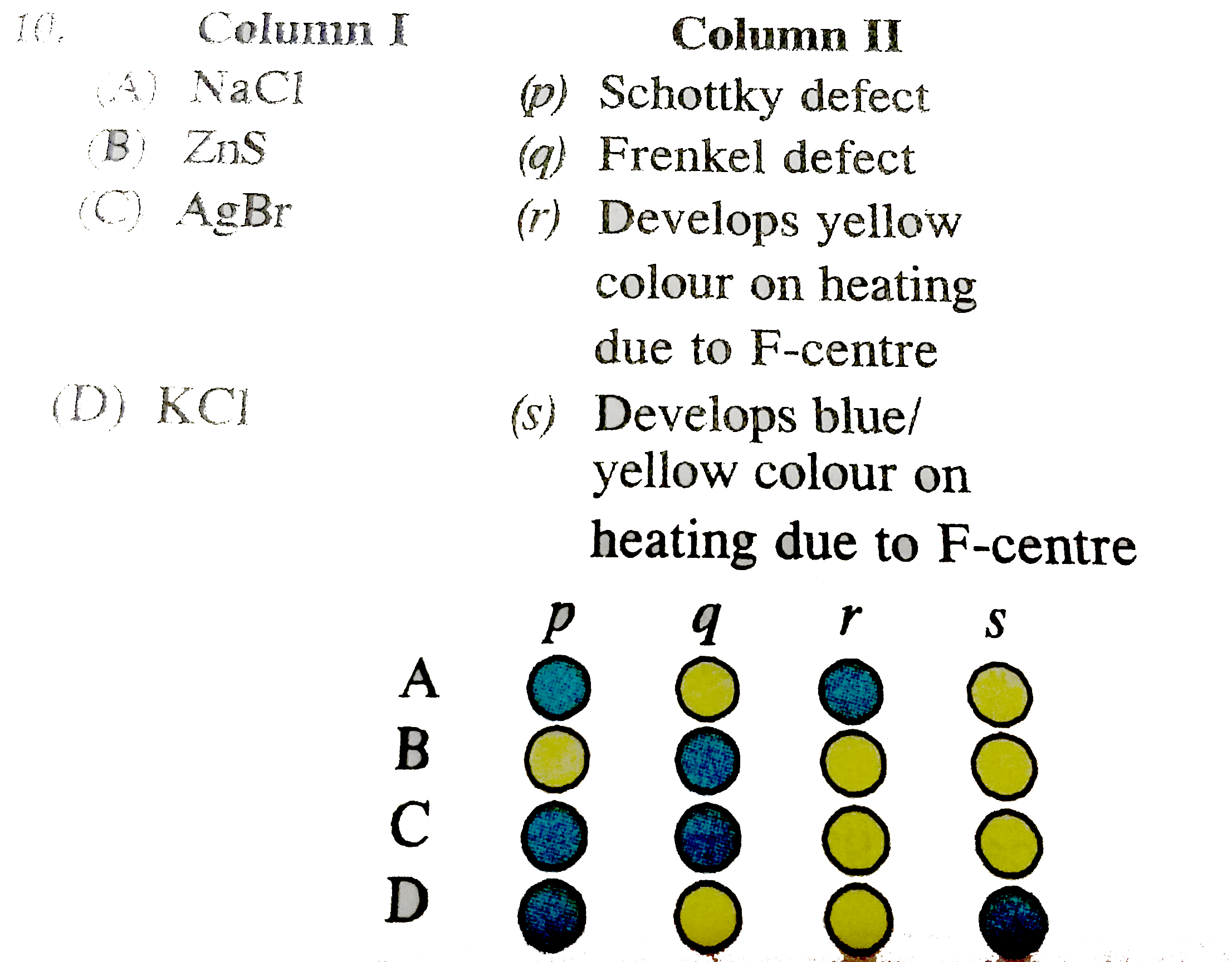Matrix from S DINESH & CO CHEMISTRY (HINGLISH) SOLID STATE for Class 12
| Class 12 | CHEMISTRY |
| Chapter | SOLID STATE |
| S DINESH & CO CHEMISTRY (HINGLISH) | Matrix |
| Medium | English |
| Academic Year | 2023-2024 |
Question 15
A compound made up of elements A and B crystallizes in the cubic structures. Atoms A are present on the corners as well as face centres whereas atoms B are present on the edge centres centres as well as body centre. What is the formula of the compound? Draw the structure of its unit cell.View SolutionQuestion 25
In a crystalline solid, having formula AB2O4 oxide ions are arranged in cubic close packed lattice while cations A are present in tetrahedral voids and cations B are present in octahedral voids.
(a) What percentage of the tetrahedral voids is occupied by A?
(b) What percentage of the octahedral voids is occupied by B ?View SolutionQuestion 26
a. MgO has the structure of NaCl and TICI has the structure of CsCl . What are the coordiantion number of the ions in MgO and TICI?
If the closed-packed cations in an XY-type solid have a raidus of 73.2 pm, what would be the maximum and minimum sizes of the anions filling voids?
c. Fe2O3 (haematite) forms ccp arrangement of O2− ions with Fe3+ ions occupying initerstitial positions. Predict whether fe3+ ions are in the OV or TV. Given r_(Fe^(3+)) = 0.7 Å and rO2−=1.4Å
d. A solid XY has CsCl-type structure. The edge length of the unit cell is 400± Calculate the distance of closest approach between X⊕ and Yɵ ions.View SolutionQuestion 28
In a face centered lattice of X and Y, X atoms are present at the corners while Y atoms are at face centres.
(a) What is the formula of the compound ?
(b) What would be the formula of the compound if (i) one of the X atoms is missing from a corner in each unit cell
(ii) one of the X atoms at from a corner is replaced by Z atom. (also monovalent) ?View SolutionQuestion 42
Silver crystallises in a face centred cubic unit cell. Each side of the unit cell has a length of 400 pm. Calculate radius of the silver atoms (Assume that the atoms just touch each other on the diagonal across the face of the unit cell i.e. each face atom is touching four atoms)View SolutionQuestion 44
A cubic unit cell contains manganese ions at the corners and fluoride ions at the centre of each face.
(a) What is the empirical formula ? (b) What is the C.N. of Mn2+ ion ?
(c) Calculate the edge length of the unit cell if the radius of Mn2+ ion is 0.65Å and that of F− ion is 1.36Å.View SolutionQuestion 64
An element crystallizes into a structure which may be describes by a cubic type of unit cell having one atom on each corner of the cube and two atoms on one of its diagonals. If the volume of this unit cell is 24×10−24cm3 and density of element is 7.2gcm−3 . Calculate the number of atoms present in 200g of element. View SolutionQuestion 132
Assertion :- (A) total number of octahedral voids present in unit cell of cubic close of each packing including the one that is present at the body centre . Is four .
Reason :- ( R) Besides the body centre there is one octahedral void present at the centre of each of the six faces of the unit cell and each of which is shared between two adjeccent units cells.View SolutionQuestion 323
The unit cell of a binary compound of A and B has ccp structure with A atoms occupying the corners and B atoms occupying the centres of each face of the unit cell. If during crystallisation of the alloy, in the unit cell two atoms of A are missing, the overall composition per unit cell is :View SolutionQuestion 359
In a crystalline solid, having formula AB2O4 oxide ions are arranged in cubic close packed lattice while cations A are present in tetrahedral voids and cations B are present in octahedral voids.
(a) What percentage of the tetrahedral voids is occupied by A?
(b) What percentage of the octahedral voids is occupied by B ?View SolutionQuestion 376
The regular three dimensional arrangement of points in a crystal is known as crystal lattice and the smallest repeating pattern in the lattice is called unit cell. The unit cells are characterised by the edge lengths a, b, c and the angles between them α,βandγ respectively. Based on this, there are seven crystal systems. In a cubic unit cell:
a=b=candα=β=γ=90∘ The number of points in simple, body centred and face centred cubic cells are 1,2 and 4 respectively In both the hcp and ccp of spheres, the number of tetrahedral voids per sphere is two while the octahedral voids is one.
In a face centred cubic cell, an atom at the face contributes to the unit cellView SolutionQuestion 377
The regular three dimensional arrangement of points in a crystal is known as crystal lattice and the smallest repeating pattern in the lattice is called unit cell. The unit cells are characterised by the edge lengths a, b, c and the angles between them α,βandγ respectively. Based on this, there are seven crystal systems. In a cubic unit cell:
a=b=candα=β=γ=90∘ The number of points in simple, body centred and face centred cubic cells are 1,2 and 4 respectively In both the hcp and ccp of spheres, the number of tetrahedral voids per sphere is two while the octahedral voids is one.
A double triangular void surrounded by three spheres above and three spheres below is called View SolutionQuestion 378
The regular three dimensional arrangement of points in a crystal is known as crystal lattice and the smallest repeating pattern in the lattice is called unit cell. The unit cells are characterised by the edge lengths a, b, c and the angles between them α,βandγ respectively. Based on this, there are seven crystal systems. In a cubic unit cell:
a=b=candα=β=γ=90∘ The number of points in simple, body centred and face centred cubic cells are 1,2 and 4 respectively In both the hcp and ccp of spheres, the number of tetrahedral voids per sphere is two while the octahedral voids is one.
The C.N of cation occuppying an octahedral vois is:View SolutionQuestion 379
In an ideal crystal, the entropy of the constituents at absolute zero temperature (0K) is zero. However, the crystals generally suffer from certain defects also called imperfections They may be both electronic and atomic in nature. The atomic imperfections may be stoichiometric (Schottky and Frenkel defects) or non-stoichiometric (metal excees and metal deficiency defects). In addition to these, there are impurity defects which are caused by the addition of certain impurities of metals and this is known as dopping. The dopping leads to semi conductors which may be either n-type or p-type in nature.
Ionic solids with Schottky defects contain in their structureView SolutionQuestion 380
In an ideal crystal, the entropy of the constituents at absolute zero temperature (0K) is zero. However, the crystals generally suffer from certain defects also called imperfections They may be both electronic and atomic in nature. The atomic imperfections may be stoichiometric (Schottky and Frenkel defects) or non-stoichiometric (metal excees and metal deficiency defects). In addition to these, there are impurity defects which are caused by the addition of certain impurities of metals and this is known as dopping. The dopping leads to semi conductors which may be either n-type or p-type in nature.
Which of the following is correct ?View SolutionQuestion 381
In an ideal crystal, the entropy of the constituents at absolute zero temperature (0K) is zero. However, the crystals generally suffer from certain defects also called imperfections They may be both electronic and atomic in nature. The atomic imperfections may be stoichiometric (Schottky and Frenkel defects) or non-stoichiometric (metal excees and metal deficiency defects). In addition to these, there are impurity defects which are caused by the addition of certain impurities of metals and this is known as dopping. The dopping leads to semi conductors which may be either n-type or p-type in nature.
Silicon doped with arsenic isView SolutionQuestion 382
In an ideal crystal, the entropy of the constituents at absolute zero temperature (0K) is zero. However, the crystals generally suffer from certain defects also called imperfections They may be both electronic and atomic in nature. The atomic imperfections may be stoichiometric (Schottky and Frenkel defects) or non-stoichiometric (metal excees and metal deficiency defects). In addition to these, there are impurity defects which are caused by the addition of certain impurities of metals and this is known as dopping. The dopping leads to semi conductors which may be either n-type or p-type in nature.
Zinc oxide (ZnO) is white when cold and yellow when hot. It is due to the development of :View SolutionQuestion 383
In an ideal crystal, the entropy of the constituents at absolute zero temperature (0K) is zero. However, the crystals generally suffer from certain defects also called imperfections They may be both electronic and atomic in nature. The atomic imperfections may be stoichiometric (Schottky and Frenkel defects) or non-stoichiometric (metal excees and metal deficiency defects). In addition to these, there are impurity defects which are caused by the addition of certain impurities of metals and this is known as dopping. The dopping leads to semi conductors which may be either n-type or p-type in nature.
In stoichiometric defects, the ratio of positive and negative ions as indicated by chemical formula of the compound:View SolutionQuestion 384
In an ideal crystal, the entropy of the constituents at absolute zero temperature (0K) is zero. However, the crystals generally suffer from certain defects also called imperfections They may be both electronic and atomic in nature. The atomic imperfections may be stoichiometric (Schottky and Frenkel defects) or non-stoichiometric (metal excees and metal deficiency defects). In addition to these, there are impurity defects which are caused by the addition of certain impurities of metals and this is known as dopping. The dopping leads to semi conductors which may be either n-type or p-type in nature.
Which is the correct statement regarding F-centres ?View SolutionQuestion 385
In a hexaonal system system of cycstals, a frequently encountered arrangement of atoms is described as a hexagonal prism. Here, the top and bottom of the cell are refular hexagons, and three atoms are sandwiched in between them. A space-cilling model of this structure, called hexagonal close-paked is constituted of a sphere on a flat surface surrounded in the same plane by six identical spheres as closely as possible. Three spherres are then placed overt the first layer so that they toych each other and represent the second layer so that they toych each other and present the second layer. Each one of the three spheres touches three spheres of the bottom layer. Finally, the second layer is convered with a third layer identical to the bottom layer in relative position. Assume the radius of every sphere to be r.
The number of atom in this hcp unit cell isView SolutionQuestion 386
In a hexaonal system system of cycstals, a frequently encountered arrangement of atoms is described as a hexagonal prism. Here, the top and bottom of the cell are refular hexagons, and three atoms are sandwiched in between them. A space-cilling model of this structure, called hexagonal close-paked is constituted of a sphere on a flat surface surrounded in the same plane by six identical spheres as closely as possible. Three spherres are then placed overt the first layer so that they toych each other and represent the second layer so that they toych each other and present the second layer. Each one of the three spheres touches three spheres of the bottom layer. Finally, the second layer is convered with a third layer identical to the bottom layer in relative position. Assume the radius of every sphere to be r.
The voume of this hcp unit cell isView SolutionQuestion 387
In a hexaonal system system of cycstals, a frequently encountered arrangement of atoms is described as a hexagonal prism. Here, the top and bottom of the cell are refular hexagons, and three atoms are sandwiched in between them. A space-cilling model of this structure, called hexagonal close-paked is constituted of a sphere on a flat surface surrounded in the same plane by six identical spheres as closely as possible. Three spherres are then placed overt the first layer so that they toych each other and represent the second layer so that they toych each other and present the second layer. Each one of the three spheres touches three spheres of the bottom layer. Finally, the second layer is convered with a third layer identical to the bottom layer in relative position. Assume the radius of every sphere to be r.
The empty space in this hcp unit cell isView SolutionQuestion 388
Packing refers to the arrangement of constituent units in such a way that the forces of attraction among the constituent particles is the maximum and the contituents occupy the maximum available space. In two dimensions, there are hexagonal close packing and cubic close packing. In three dimentions, there are hexagonal, cubic as well as body centred close packings.
The empty space left in hcp packing is:View SolutionQuestion 389
Packing refers to the arrangement of constituent units in such a way that the forces of attraction among the constituent particles is the maximum and the contituents occupy the maximum available space. In two dimensions, there are hexagonal close packing and cubic close packing. In three dimentions, there are hexagonal, cubic as well as body centred close packings.
The pattern of successive layers in ccp arrangement is:View SolutionQuestion 390
Packing refers to the arrangement of constituent units in such a way that the forces of attraction among the constituent particles is the maximum and the contituents occupy the maximum available space. In two dimensions, there are hexagonal close packing and cubic close packing. In three dimentions, there are hexagonal, cubic as well as body centred close packings.
The space occupied by spheres in bcc arrangement is:View SolutionQuestion 391
Packing refers to the arrangement of constituent units in such a way that the forces of attraction among the constituent particles is the maximum and the contituents occupy the maximum available space. In two dimensions, there are hexagonal close packing and cubic close packing. In three dimentions, there are hexagonal, cubic as well as body centred close packings.
A certain oxide of a metal M crystallises in such a way that O2− ions occupy hcp arrangement following ABAB... pattern. The metal ions however occupy 2/3 rd of the octahedral voids. The formula of the compound is :View Solution
All Exercises from S DINESH & CO CHEMISTRY (HINGLISH) Class 12 CHEMISTRY SOLID STATE
- A.R
- ASSIGNMENT
- BRAIN STORMING
- COMPREHENSION
- INTEGER
- MATRIX
- MULTIPLE CHOCIE QUESTION (TYPE-I)
- MULTIPLE CHOICE
- PROBLEMS
- SELECT THE CORRECT
- STRAIGHT OBJECTIVE
- A.R
- ASSIGNMENT
- BRAIN STORMING
- COMPREHENSION
- INTEGER
- MATRIX
- MULTIPLE CHOCIE QUESTION (TYPE-I)
- MULTIPLE CHOICE
- PROBLEMS
- SELECT THE CORRECT
- STRAIGHT OBJECTIVE
- QUESTION BANK
- A.R
- ASSIGNMENT
- BRAIN STORMING
- COMPREHENSION
- INTEGER
- MATRIX
- MULTIPLE CHOCIE QUESTION (TYPE-I)
- MULTIPLE CHOICE
- PROBLEMS
- SELECT THE CORRECT
- STRAIGHT OBJECTIVE
- A.R
- ASSIGNMENT
- BRAIN STORMING
- COMPREHENSION
- INTEGER
- MATRIX
- MULTIPLE CHOCIE QUESTION (TYPE-I)
- MULTIPLE CHOICE
- PROBLEMS
- SELECT THE CORRECT
- STRAIGHT OBJECTIVE
- QUESTION BANK
- A.R
- ASSIGNMENT
- BRAIN STORMING
- COMPREHENSION
- INTEGER
- MATRIX
- MULTIPLE CHOCIE QUESTION (TYPE-I)
- MULTIPLE CHOICE
- PROBLEMS
- SELECT THE CORRECT
- STRAIGHT OBJECTIVE
- A.R
- ASSIGNMENT
- BRAIN STORMING
- COMPREHENSION
- INTEGER
- MATRIX
- MULTIPLE CHOCIE QUESTION (TYPE-I)
- MULTIPLE CHOICE
- PROBLEMS
- SELECT THE CORRECT
- STRAIGHT OBJECTIVE
- QUESTION BANK
- EXAMPLE
- HIGHER ORDER THINKING SKILLS (HOTS) QUESTIONS
- N.C.E.R.T
- N.C.E.R.T.
- QUESTION FROM BOARD EXAMINATION
- EXAMPLE
- HIGHER ORDER THINKING SKILLS (HOTS) QUESTIONS
- N.C.E.R.T
- N.C.E.R.T.
- QUESTION FROM BOARD EXAMINATION
- EXAMPLE
- HIGHER ORDER THINKING SKILLS (HOTS) QUESTIONS
- N.C.E.R.T
- N.C.E.R.T.
- QUESTION FROM BOARD EXAMINATION
- EXAMPLE
- HIGHER ORDER THINKING SKILLS (HOTS) QUESTIONS
- N.C.E.R.T
- N.C.E.R.T.
- QUESTION FROM BOARD EXAMINATION
- EXAMPLE
- HIGHER ORDER THINKING SKILLS (HOTS) QUESTIONS
- N.C.E.R.T
- N.C.E.R.T.
- QUESTION FROM BOARD EXAMINATION
- EXAMPLE
- HIGHER ORDER THINKING SKILLS (HOTS) QUESTIONS
- N.C.E.R.T
- N.C.E.R.T.
- QUESTION FROM BOARD EXAMINATION

